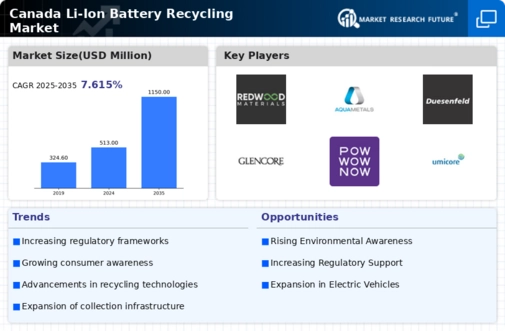The Canada Li-Ion Battery Recycling Market is gaining significant traction as the demand for sustainable recycling solutions continues to grow amidst increasing awareness regarding environmental concerns and regulations around battery waste. As electric vehicle adoption accelerates and the use of Li-ion batteries becomes more ubiquitous across various sectors, the recycling landscape in Canada is evolving rapidly. Competitive insights in this market reveal a diverse range of players, each striving for innovation and efficiency in recycling processes.
Companies within this sphere are not only focused on recovering valuable materials but are also developing sustainable practices that adhere to provincial and national regulatory frameworks.
The market is characterized by strategic partnerships, technological advancements, and an emphasis on maintaining a circular economy that benefits both consumers and manufacturers alike.Redwood Materials has established a robust presence in the Canada Li-Ion Battery Recycling Market by focusing on its core competencies in battery recycling and material recovery technology. The company boasts several strengths, including advanced recycling techniques that enable the reclamation of critical materials such as lithium, cobalt, and nickel from spent batteries.
These competencies not only enhance the sustainability of battery production but also reduce the environmental footprint associated with the extraction of raw materials. In Canada, Redwood Materials has built strategic alliances with key stakeholders across the manufacturing and automotive sectors, bolstering its influence in the market. With a commitment to innovation and operational efficiency, Redwood Materials is well-positioned to leverage the growing demand for recycling solutions while contributing significantly to the circular economy in the region.Aqua Metals is another prominent player in the Canada Li-Ion Battery Recycling Market that focuses on the development and implementation of innovative recycling technologies.
The company has gained recognition for its proprietary AquaRefining process, which facilitates the safe and environmentally-friendly recycling of lead-acid batteries and is now making strides toward broader applications, including Li-ion batteries. Aqua Metals offers a suite of services that emphasize low-impact recycling methods while enhancing the recovery of valuable materials. In Canada, the company has expanded its market presence through strategic mergers and acquisitions, which have allowed it to bolster its technological capabilities and infrastructure.
The company's strengths lie in its commitment to research and development, enabling the innovation of further refined processes and contributing to sustainability goals in the region. With a clear focus on the Canadian market, Aqua Metals is poised to capitalize on the surging demand for Li-ion battery recycling while ensuring compliance with regulatory standards.


















Leave a Comment